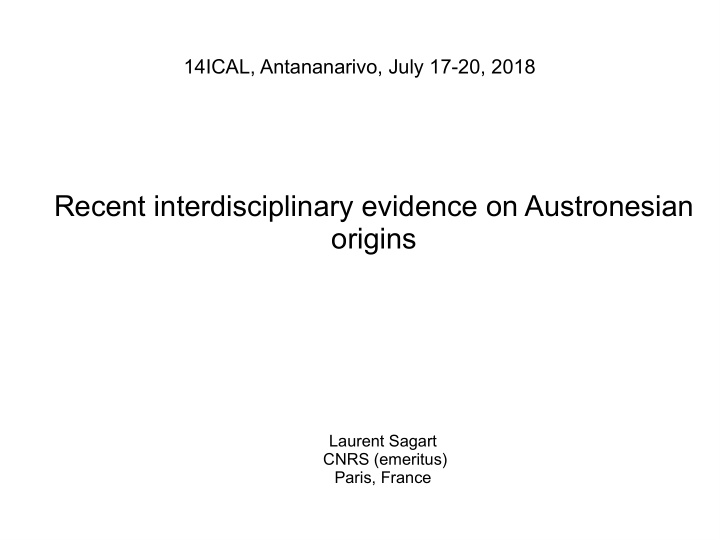



14ICAL, Antananarivo, July 17-20, 2018 Recent interdisciplinary evidence on Austronesian origins Laurent Sagart CNRS (emeritus) Paris, France
The dominant story ● Full domestication by 4500 BCE ● Large grains ● Permanent fields with water control Nan Kuan Li East: ? Rice after 3000BCE ● Rice is morphologically primitive ● small grains ● No permanent fields
Sagart, L. (2005) Sino-Tibetan- Austronesian: an updated and improved argument. In L. Sagart, R. Blench and A. Sanchez-Mazas (eds) The peopling of East Asia: Putting together Archaeology, Linguistics and Genetics 161- 176 . London: RoutledgeCurzon.
STAN Sino-Tibetan Austronesian
Linguistic evidence for STAN ● lexical comparisons (61 basic, 14 cultural) ● sound correspondences ● morphological parallels
Homeland ● in the Yellow Valley, north China ● Cishan-Peiligang culture ● 9000-7500 BP (true date may be older) ● Population expansion fueled by millet domestication
foxtail millet plant ● PAN *beCeŋ – Old Chinese 稷 *[ts]ək – Trung tɕjaʔ 55 – Lhokpu cək ● ST # CVtsək – -C- : ts- – -e- : -ə- – -ŋ- : -k-
Criticism of the lexical comparisons ● Blust 2009
Criticism of the morphology ● Kaufman, Daniel. 2013. Reviewing the place of PAn within Asia . Paper presented at SEALS 23, May 29-31, Bangkok, Thailand
my response: Diachronica 33, 2:255-281 (2016)
The path of the Austronesian expansion (Sagart 2008)
From PSTAN to PAN Houli, Beixin, Dawenkou cultures c. 8000-7000 BP PSTAN Cishan-Peiligang culture 2 c. 9000-7500 BP 1 coastal expansion 7000-5500 BP PAN Taiwan west coast 5200 BP
Chris J Stevens, Charlene Murphy, Rebecca Roberts, Leilani Lucas, Fabio Silva and Dorian Q Fuller (2016) “A strong case for the movement of crops through rapid long-distance migration of small groups is suggested for the entry of agriculture into Taiwan from Shandong, a journey of some1400 km mostly by sea (see Sagart, 2008; Stevens and Fuller, in press).” Between China and South Asia: A Middle Asian corridor of crop dispersal and agricultural innovation in the Bronze Age. The Holocene 1–15, 2016
Deng et al. 2017 Zhenhua Deng, Hsiao-chun Hung, Xuechun Fan, Yunming Huang and Houyuan Lu (2017 The ancient dispersal of millets in southern China: New archaeological evidence. The Holoccene, 1-10.
Even Bellwood... ● Bellwood 2017 “But the early Austronesians were not ‘Chinese’ – they did not speak Sinitic languages or have any obvious direct connections with the roots of Chinese culture in the Yellow River Valley (although I should add here that linguist Laurent Sagart believes there were such connections during the Neolithic, and to me this possibility is extremely interesting).”
Evidence for this scenario
I. Agriculture ● An agriculture based on two millets: foxtail millet broomcorn millet ● with rice as a third cereal
early AN agriculture and Shandong agriculture ● the two millets were domesticated in north China: oldest sites belong to Cishan-Peiligang culture (stage 1, PSTAN) ● the Shandong cultures (stage 2) rely on the millets with a little rice ● Nan Kuan Li East (Tainan, 3000-2200 BCE) has all three cereals ● This system still in place today in Taiwan: rice has grown in importance but foxtail millet is central to religion. ● millets absent in or south of the Yangtze before 4000 BCE
II tooth ablation ● ritual ablation of upper lateral incisors ● in young men and women ● generalized in the earliest Formosan neolithic Source: Pietrusewsky M, Lauer A, Tsang C-h, Li K-t, Douglas MT. 2016. Tooth ablation in early Neolithic skeletons from Taiwan. In Burnett SE, Irish JD, editors. A World View of (Bio)Culturally Modified Teeth: Past and Present. Gainesville: University Press Florida.
Han and Nakahashi (1996)
Yang Shiting (2005)
Ritual tooth ablation ● originates in Shandong c. 5000 BCE ● gradually spreads south along coastal route
Han and Nakahashi (1996)
Han and Nakahashi (1996) earliest date c. 5000 BCE earliest date c. 4000 BCE earliest date c. 3000 BCE
III mtDNA — Ko et al. 2014 The American Journal of Human Genetics 94, 426– 436, March 6, 2014
split between 6000 and 8000 BC mtDNA Haplogroup E Sino-Tibetan Austronesian
migration route suggested by Ko et al. (2014)
IV. Y-chromosome: Wei et al. 2017
Haplogroup M122, predominant among Sino-Tibetans, Hmong-Miens, Austronesians distributed along the east coast of China, from Korea to Vietnam unique to Austronesians
migration route
Conclusion ● Convergent evidence from: – agricultural archaeology – tooth ablation – mtDNA, Y chromosome ● the Pre-Austronesians expanded south from Shandong along the East China coast ● before reaching Taiwan c. 3500 BCE.
Thank you for your attention.
Recommend
More recommend